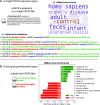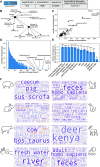Achieving pan-microbiome biological insights via the dbBact knowledge base
- PMID: 37326027
- PMCID: PMC10359611
- DOI: 10.1093/nar/gkad527
Achieving pan-microbiome biological insights via the dbBact knowledge base
Abstract
16S rRNA amplicon sequencing provides a relatively inexpensive culture-independent method for studying microbial communities. Although thousands of such studies have examined diverse habitats, it is difficult for researchers to use this vast trove of experiments when interpreting their own findings in a broader context. To bridge this gap, we introduce dbBact - a novel pan-microbiome resource. dbBact combines manually curated information from studies across diverse habitats, creating a collaborative central repository of 16S rRNA amplicon sequence variants (ASVs), which are assigned multiple ontology-based terms. To date dbBact contains information from more than 1000 studies, which include 1500000 associations between 360000 ASVs and 6500 ontology terms. Importantly, dbBact offers a set of computational tools allowing users to easily query their own datasets against the database. To demonstrate how dbBact augments standard microbiome analysis we selected 16 published papers, and reanalyzed their data via dbBact. We uncovered novel inter-host similarities, potential intra-host sources of bacteria, commonalities across different diseases and lower host-specificity in disease-associated bacteria. We also demonstrate the ability to detect environmental sources, reagent-borne contaminants, and identify potential cross-sample contaminations. These analyses demonstrate how combining information across multiple studies and over diverse habitats leads to better understanding of underlying biological processes.
© The Author(s) 2023. Published by Oxford University Press on behalf of Nucleic Acids Research.
Figures







References
-
- Smil V. The Earth's Biosphere: Evolution, Dynamics, and Change. 2003; MIT Press.
Publication types
MeSH terms
Substances
LinkOut - more resources
Full Text Sources
Miscellaneous

